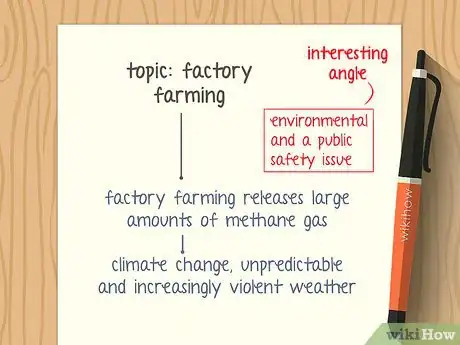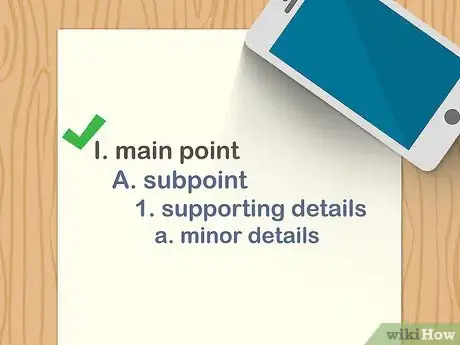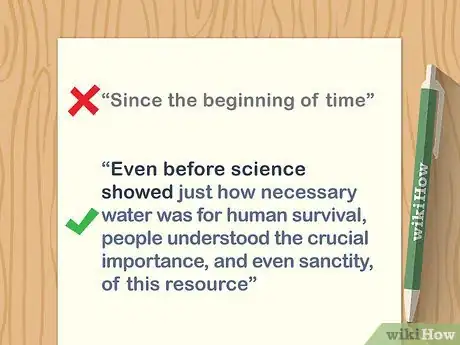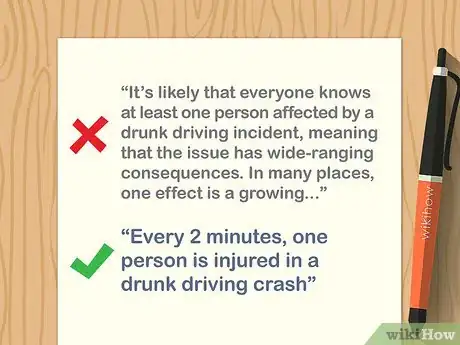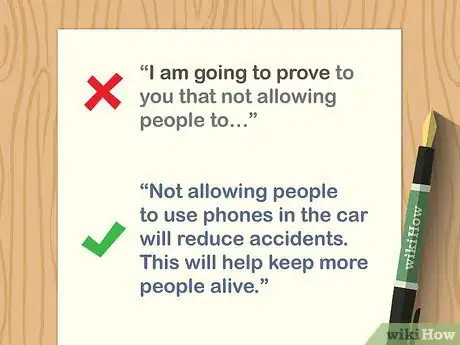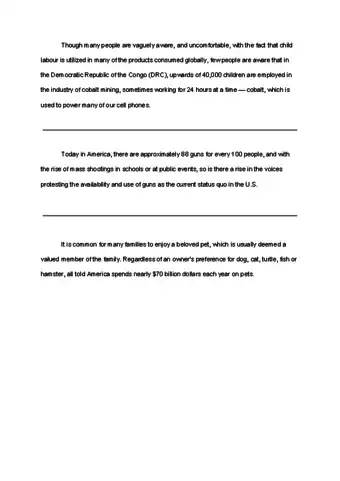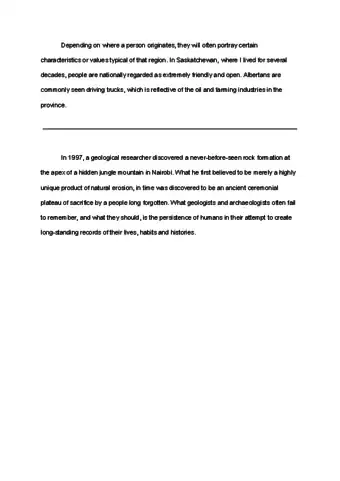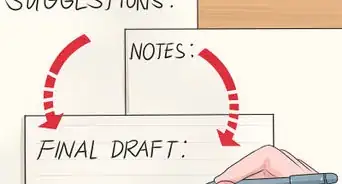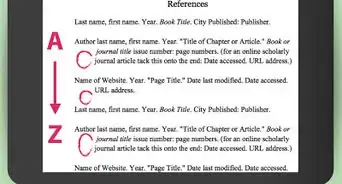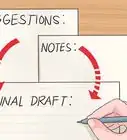This article was co-authored by Christopher Taylor, PhD. Christopher Taylor is an Adjunct Assistant Professor of English at Austin Community College in Texas. He received his PhD in English Literature and Medieval Studies from the University of Texas at Austin in 2014.
There are 9 references cited in this article, which can be found at the bottom of the page.
This article has been viewed 332,020 times.
The goal of a persuasive essay is to convince your readers of a certain perspective on a topic. To do this, you'll have to get them hooked with a well-crafted, engaging introductory section that leads into a developed thesis statement. The best opening, however, will depend on the issue at hand, the argument you are trying to make about it, and the audience you are trying to persuade. Before you can write an amazing introduction, you need to do some initial research so that you can tailor your introduction to the needs of the essay, your argument, and your audience.
Steps
Brainstorming and Outlining Introduction Ideas
-
1Pick a topic, if you haven’t already. If you’re choosing your own topic for your persuasive essay, think about current issues that you find interesting, have a concrete stance on, or that you’d like to learn more about. You can also look up persuasive essay topics online or ask friends and family for suggestions. Make sure to choose a topic that’s narrow and specific so you can come up with a pointed angle on it.
- For example, if you want to write about juvenile crime, choose a narrow section of it, such as the practice of trying juveniles as adults in certain cases.
- Try to choose a topic that’s really interesting to you. It will make the essay much more fun to write!
- The subject of your essay might be predetermined if, for example, you’re writing an essay for class or are sending it to a senator or a newspaper about a certain topic.
-
2Choose an angle that seems the most interesting to write. Once you’ve chosen your topic, start to think about what you want to say about it. Why do you feel strongly about it? What is your solution to this problem or issue? Brainstorm possible angles, choosing one that feels most interesting to you or matches most closely with your natural beliefs.[1]
- Ask yourself what is at stake regarding the issue you are researching. Why does the issue matter and why should others care? Once you can identify that, it will be easier to frame your argument.
- For example, if your topic is factory farming, your angle could be that factory farming releases large amounts of methane gas, which contribute to climate change and the global epidemic of unpredictable and increasingly violent weather. You could frame it as both an environmental and a public safety issue.
Advertisement -
3Do some research to find supporting evidence. Start doing research on your topic online and in the library to build up your knowledge base. Take notes while you read to point out any pieces of evidence you could use or any arguments that are starting to form. Although you won’t use most of this research in your introduction, familiarizing yourself with it now will help you pinpoint the most effective ways to introduce it.
- Use scholarly search engines such as Google Scholar, EBSCO, or JSTOR, rather than regular searches, and try to use trustworthy sites like news agencies and .edu URLs.
-
4Come up with 3-5 pieces of evidence to support your argument. As you sift through your research, start to coalesce the most accurate and striking arguments you see into pieces of supporting evidence. In a persuasive essay, this supporting evidence can appeal to the reader’s sense of reason (logos), ethics (ethos), or emotions (pathos).
- You’ll be hinting at your evidence in your introductory paragraph, so it’s important that you know what it is before you start writing.
- A piece of evidence that appeals to the reader’s ethics is one that comes from a trustworthy source. For example, if you’re writing an essay on the use of euthanasia, you could cite works or quotations from doctors or end-of-life caregivers who have direct experience working with it.
- In a paper persuading people to decrease their water use, a piece of evidence that appeals to your sense of logic could be something like, “Using more water not only wastes more of this resource, but also increases your utilities bill.”
- In a paper persuading people to adopt animals from the shelter, you could use an emotional appeal like, “Milo, a golden retriever puppy, was found on the side of the road when he was just 4 weeks old. If he’s not adopted soon from his overcrowded shelter, he’ll have to be put down.”
-
5Sketch out a thesis statement. Once you’ve gathered your preliminary research, think back to the angle you’ve chosen and flesh it out more, if you can. Write it down as 1-2 clear, concise sentences that hint at the evidence you’ll be presenting later on. This will serve as the rough draft of your thesis statement.
- For example, if you started with the angle that capital punishment should be illegal worldwide, you could expand that into a thesis like, “Capital punishment should be banned all over the world for humanitarian reasons alone, but also because of its lack of efficacy as a crime deterrent.”
-
6Organize your ideas into an outline. Creating an outline before you start writing will help your paper be more structured and organized. Go with a basic 5-paragraph structure, with 1 paragraph for your introduction, 3 paragraphs for 3 pieces of evidence, and 1 paragraph for your conclusion. Jot down bullet points and brief sentences for each section to outline what you want to include.
- Your paper can go longer than this, but try not to go any shorter, since you won’t be able to include all of the evidence you’ll need.
- You can organize your outline with Roman numerals, regular numbers, or bullet points—whatever feels most comfortable to you.
Crafting Your Hook
-
1Use a startling fact or quote to pique your reader’s interest. A hook is made up of a few sentences at the very start of your essay that catch your reader’s attention while explaining the significance of your argument. One way to do this is to start off with a surprising fact or interesting quotation that has to do with your subject. Choose a one-line quote or statistic to most effectively grab your reader’s focus and entice them to read more.[2]
- For example, in a paper persuading people to support prison reform, you could start off with something like, “The United States has the largest prison population in the entire world. The country that comes closest, China, has a prison population that is a full 25% lower.”[3]
- To introduce a paper about capital punishment, you could use a quote like, “When discussing capital punishment, two quotes are often brought up: ‘an eye for an eye,’ and ‘an eye for an eye makes the whole world blind.”
- If you use one of these approaches, remember to include a brief, 1-sentence explanation of why you’re including it. Don’t just start off with a quote or statistic, then jump straight into your background information.
-
2Begin with a brief anecdote to make the topic relatable. An anecdote is a great way to draw the reader into an essay that’s going to rely heavily on emotional arguments. On the flip side, it can also be a good strategy for personalizing a topic that’s less relatable or human. You can choose to relate a brief story of something that happened to you, or try relating an example in a short, story-like format.[4]
- For example, in a paper on reforming the juvenile justice system, you could say something like, “Joseph Creedwell was only 14 years old when he was first sent to a juvenile detention facility. His crime? Stealing a pack of gum from the convenience store across from his school.”
- If you’re using a personal anecdote, first make sure that this format is appropriate for first-person narration. If it’s an essay for a class, ask your teacher.
-
3Start with a broad generalization, then zoom in on your topic. Starting your essay with a broad perspective and slowly narrowing in on the topic feels natural to write and to read, with the effect of easing the reader into your paper. You can also do the opposite, starting with a small example and slowly working outwards to maker a broader statement.
- For example, in an essay about conserving water use, you could say something like, “Even before science showed just how necessary water was for human survival, people understood the crucial importance, and even sanctity, of this resource.”
- Try to avoid cliches like "Since the beginning of time," or "The dictionary defines _____ as..."
-
4Use a rhetorical question to get your reader thinking. Asking your reader a question is a direct way to start your essay, bringing the reader straight into the action and forcing them to start thinking about your topic. It’s a start that feels natural and interesting, but make sure to choose a question that’s truly thought-provoking, not one with an obvious answer.[5]
- For example, in an essay on animal protection, you could write, “Many people know that animal species are going extinct, but have you ever wondered exactly how many species have died out since you’ve been born?”
-
5Present a counter-argument first to make an interesting switch. Starting your essay with a counter-argument is a particularly intriguing way to begin, and can make you seem like a fair and deep-thinking writer before you’ve even presented any evidence. This strategy can be great for topics that are particularly emotionally fraught, that readers are likely to have opinions about already.
- In an essay against the use of euthanasia, for example, you could write, for example, “According to its supporters, euthanasia is a merciful and painless way to end a life that is no longer wanted, and they have a point.”
Introducing Your Topic and Thesis
-
1Write 1-2 sentences introducing your specific topic. Once you’ve hooked your readers, it’s time to show them exactly what your topic is and why it’s important. In a few sentences, tell them why you’re sharing this, why they should care, and why it matters as a whole.[6]
- For example, in an essay against capital punishment, you could say something like, “Capital punishment directly affects a very small percentage of the population, but its ripple effects—the effects on the person’s family and friends, on the people who read about it and hear of it—are much larger. In an even greater sense, capital punishment is a statement about the society we live in.”
-
2Provide any necessary background the reader will need. You should assume, unless told otherwise, that your audience has very little knowledge of your topic. It’s your job to fill in the gaps with information that’s directly pertinent to your argument, which could be facts, historical background, or any other stage-setting information. This gives the reader a foothold in your paper and prepares them for the rest of the paper.[7]
- For example, in a persuasive essay on gun control, you could write, “Gun control laws have a long and fraught history in the United States, and understanding the nature of their back-and-forth growth and decline is crucial for understanding the current state of weapons law.”
- Depending on your paper, your background information could take up anywhere from 2-3 sentences to a whole paragraph.
-
3Clearly state your position in your thesis statement. Your thesis statement will be the backbone of your essay, capturing your angle on your topic, what is at stake, and what you think should be done about it, based on your evidence. It’s typically 1-2 sentences long, but can be even longer for bigger essays. You should use the strongest, clearest, and most concise language you can to show your readers exactly what you think and why.[8]
- For example, in an essay persuading people to oppose a new park project, you could write, “As much as a new park benefits a city’s residents, natural green space is vital to the environmental life of a community. Besides serving as an interesting insight into what the area was like before development, it provides crucial habitat for native plants and animals that may otherwise turn to residential space and face endangerment in urban an environment.”
-
4Hint at your evidence to transition into your first body paragraph. In or after your thesis statement, you can also start to hint at the evidence you’ll be presenting later in the essay, with a particular emphasis on the first body paragraph. This allows the essay to move smoothly from your introductory material into supporting evidence.
- For example, in an essay supporting the use of euthanasia, you could write, “Nowhere is the efficacy of euthanasia more visible than in the cases of patients with painful, terminal diseases.” This kind of sentence could either go at the end of your introduction paragraph or at the beginning of the first body paragraph.
Avoiding Common Mistakes
-
1Avoid presenting and analyzing evidence in the introduction. Your evidence is strong and interesting, and it’s natural to want to jump into it right away! However, you should leave deep descriptions of your arguments and analyses of your evidence for later on in your body paragraphs. This allows you to focus completely on hooking and introducing the reader to the topic and helps you to avoid spoiling your ideas before you can fully back them up.[9]
- For example, in an essay against drunk driving, it’s fine to use an eye-catching statistic, like, “Every 2 minutes, one person is injured in a drunk driving crash.” But avoid analyzing that statistic with something like, “It’s likely that everyone knows at least one person affected by a drunk driving incident, meaning that the issue has wide-ranging consequences. In many places, one effect is a growing numbness towards the issue at all. Police officers report that...”[10]
-
2Keep your argument clear, but present it in a smooth, subtle way. You want your reader to recognize your thesis statement and main argument, but don’t make it overly obvious. This can interrupt the flow of the essay, making it a less satisfying and less persuasive reading experience. Instead, present your argument in a way that’s strong but subtle, showing readers that they’ve reached an important sentence without flagging it too much.[11]
- For example, avoid writing something like, “I am going to prove to you that…” or “This essay will show that…” These kinds of phrases are typically jarring and unnecessary.
-
3Leave out unnecessary details. Ample background information is sometimes necessary, but make sure every detail you include is necessary to persuade your reader. Including extra facts will bog them down and make your essay seem unfocused and even boring.[12]
- For example, a fact you picked up about bee flight patterns might be interesting, but isn’t relevant to a paper on why the world needs to protect its bee population.
- You may also want to leave out “book report” information, such as the full title, author, or year of publication of a book you’re writing your persuasive essay about, unless that information is for a specific purpose. You’ll be able to cite your sources in full in your bibliography or works cited page.
-
4Steer clear of extremely broad introductions. Although generalist essay introductions can sometimes feel natural and convincing, avoid making them too broad. You’re writing a persuasive essay to convince a reader to take a particular stance on an issue—there’s no need to relate it back to greater human existence![13]
- For example, in an essay about vegetarianism, avoid saying something like, “People have killed and eaten animals since the beginning of time.” While this may be true, it’s not catching the reader’s attention or adding anything to the essay that they didn’t already know.
Community Q&A
-
QuestionHow would I start a persuasive essay on UFO (aliens)?
 Community AnswerStart with a hook. It could be about statistics, sightings, why it could be true, or evidence that suggests aliens are real.
Community AnswerStart with a hook. It could be about statistics, sightings, why it could be true, or evidence that suggests aliens are real. -
QuestionWhat are different topics I might use for my own five paragraph persuasive essay?
 Community AnswerYou could outline modern ideas on society today or technology. You could also talk about more general topics. Base your topics around what you think your target audience would find interesting.
Community AnswerYou could outline modern ideas on society today or technology. You could also talk about more general topics. Base your topics around what you think your target audience would find interesting. -
QuestionHow can I create a hook for an essay about refugees?
 Community AnswerTry using an emotional hook: "You're all alone. Your family have died a long time ago; your ears can still hear the ringing of the bombs. You're packed between around a hundred and fifty people covered in the waste of the people around them. You're in a boat which can fit around twenty people..."
Community AnswerTry using an emotional hook: "You're all alone. Your family have died a long time ago; your ears can still hear the ringing of the bombs. You're packed between around a hundred and fifty people covered in the waste of the people around them. You're in a boat which can fit around twenty people..."
References
- ↑ https://writingcenter.unc.edu/tips-and-tools/introductions/
- ↑ https://www.youtube.com/watch?v=baxDMu_1M0c&feature=youtu.be&t=1m19s
- ↑ https://www.georgebrown.ca/uploadedFiles/TLC/_documents/Hooks%20and%20Attention%20Grabbers.pdf
- ↑ https://education.seattlepi.com/write-good-argumentative-essay-introduction-1484.html
- ↑ https://www.youtube.com/watch?v=baxDMu_1M0c&feature=youtu.be&t=1m44s
- ↑ https://www.youtube.com/watch?v=baxDMu_1M0c&feature=youtu.be&t=1m59s
- ↑ https://www.youtube.com/watch?v=baxDMu_1M0c&feature=youtu.be&t=41s
- ↑ https://www.youtube.com/watch?v=baxDMu_1M0c&feature=youtu.be&t=47s
- ↑ https://education.seattlepi.com/write-good-argumentative-essay-introduction-1484.html
About This Article
To begin a persuasive essay, start with a hook to catch the reader’s attention, such as a startling statistic, a question, or an intriguing anecdote. Next, briefly explain why they should care about the topic and provide some background information to help them feel comfortable with it. Then, present your thesis statement, which is a short, concise explanation of your perspective and why it’s the right one. Lastly, hint at your opening pieces of evidence before going on to your first paragraph! For tips on how to organize your essay and avoid common errors, read on!

